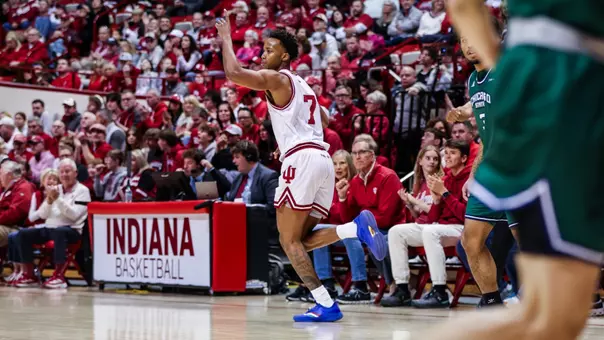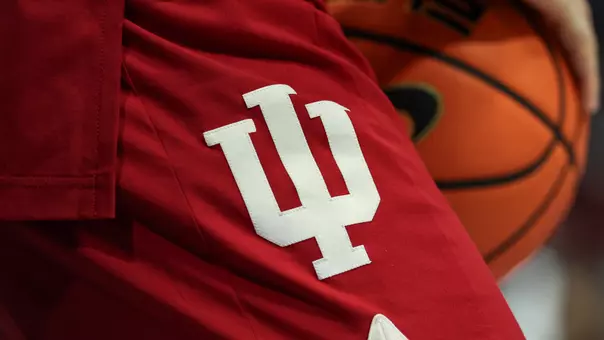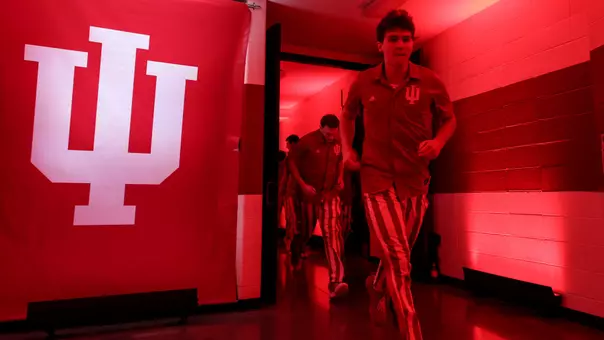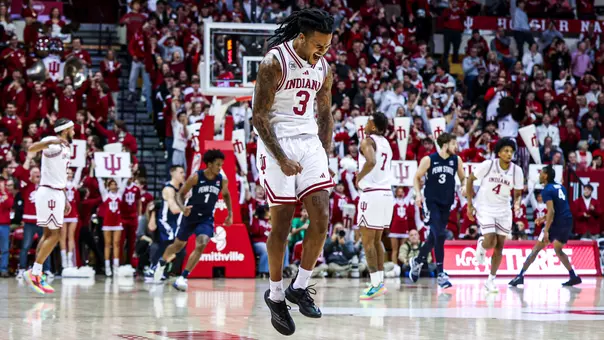Indiana University Athletics
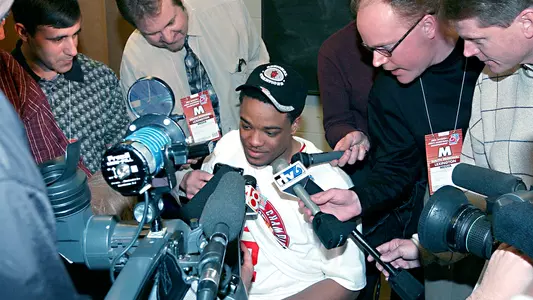
What Happened to A.J. Moye and his Unforgettable Block?
4/13/2020 1:30:00 PM | Men's Basketball, History
Note: IU Athletics is partnering with IU Press to share chapters from some of their recently-published books on IU Sports. The following is a chapter from Unknown, Untold, and Unbelievable Stories about IU Sports, published by IU Press in 2018. The second-half of this chapter will appear tomorrow on IUHoosiers.com. Additional details about this book can be found here.
How many times have you seen former IU basketball player A.J. Moye's "play?"
Which one, you ask?
No you don't.
Everyone knows his "play" is the block of an attempted dunk by future NBA All-Star Carlos Boozer in the Hoosiers' Sweet 16 win over No. 1 Duke in 2002, a victory that helped propel IU to the National Championship game.
It's a play that holds its own with Keith Smart's NCAA Championship game winner in 1987, and Christian Watford's buzzer-beater against No. 1 Kentucky in 2011. Add in Kent Benson's last-second putback against Michigan in 1976 to force overtime and preserve IU's unbeaten season and Jay Edwards' top of the key 3-pointer to beat Michigan in 1989, and you have arguably the five most memorable IU basketball plays of the last 40 years.
"I knew at the time, it was a pretty special play," Moye says, 15 years after the fact from his California home.
 For those who do need a quick refresher, the 6'2" Moye didn't just block the 6'9", 280-pound Boozer's shot. He didn't get a finger on it to ever-so-slightly steer it off course. He elevated up and over the much larger Duke center and denied both Boozer and the ball, never granting the ball permission to even exit the All-American's hands. When Boozer returned to the floor with the ball still in tow, the official's whistle blew, the ball was turned over to IU, and Moye had the defining play of his Hoosier career.
For those who do need a quick refresher, the 6'2" Moye didn't just block the 6'9", 280-pound Boozer's shot. He didn't get a finger on it to ever-so-slightly steer it off course. He elevated up and over the much larger Duke center and denied both Boozer and the ball, never granting the ball permission to even exit the All-American's hands. When Boozer returned to the floor with the ball still in tow, the official's whistle blew, the ball was turned over to IU, and Moye had the defining play of his Hoosier career.
"People used to joke that I sent him to the second round (of the NBA Draft) because 6'9" guys aren't supposed to get blocked by 6'2" guys," Moye says.
But he did deny the dunk, and Moye's late second half play – coupled with his 14 points - helped the Hoosiers overcome a 17-point deficit and upset the top-seeded Blue Devils, 74-73, in Lexington, Ky.
While it's been 15 years since Moye helped orchestrate one of the biggest upset wins in school history, the play hasn't been forgotten. It's often featured during the IU men's basketball pre-game highlight videos at Simon Skojdt Assembly Hall, and hundreds of thousands have subsequently watched it on YouTube – even though the video sharing website didn't exist until three years after the play originally happened.
So Hoosier fans have seen it – a lot.
But how many times have you seen the official boxscore from that NCAA East Regional semifinal game?
***
The boxscore is tucked away in a non-descript cardboard box in storage in Assembly Hall, along with all of the other boxscores, play-by-play accounts, and newspaper clippings from that 2001-02 season and many others. It offers the numeric details to the Hoosiers' one-point Sweet 16 win. Hoosier All-American Jared Jeffries had game highs of 24 points and 15 rebounds. Jarrad Odle added 15 points for IU. On the other side, Boozer led the Blue Devils with 19 points and nine rebounds, while fellow All-Americans Mike Dunleavy (17) and Jason Williams (15) also scored in double figures for Coach Mike Krzyzewski's team.
And Moye?
The sophomore from Atlanta came off the bench to chip in 14 points, made 8-of-10 free throws (including a critical pair in the final seconds), had a pair of steals and…no blocks.
No blocks?
While Hoosier fans' memories, video highlight footage and the NCAA statistician's manual insist otherwise, the written record of Indiana's improbable come-from-behind win will forever deny Moye credit for the play that he's remembered for most as an Indiana Hoosier.
That was news to Moye, who to this day can remember the most minute details of the play ("the ball got swung and dished down to Boozer, and Dane (Fife) was late rotating over, so I dropped down trying to make sure he couldn't lay it in"), but had never heard of its absence in the official account of the game.
"Honestly, until you brought that up, I had no idea I wasn't credited with a block," Moye says. "That's the first I've ever heard of it.
"I guess there must have been a Duke fan doing the stats."
Whatever the reason for the error, Moye says he's not surprised he was unaware of the omission. He insists he never looked at any boxscore after a game, a practice he adopted as a youth in Atlanta.
Moye said the practice came courtesy Bill Russell, the legendary Boston Celtic center who won a pair of NCAA Championships at the University of San Francisco (1955-56) before winning an NBA-best 11 world championships during a 13-year professional career in the NBA.
"I read Bill Russell's autobiography when I was about 12 or 13," Moye recalls. "Russell said one day when he was in college, he decided he'd stop checking the boxscores and instead grade himself on just two things – winning and losing. From that day forward, he said that's when he started having success."
While Moye didn't approach Russell's unparalleled record of winning, he did win a pair of high school state championships at Westlake H.S. to go along with a Big Ten title and Final Four berth during his four years in Bloomington before embarking on a six-year professional career in Europe.
He's also the owner of one of the more memorable plays in IU basketball history – regardless of what the official boxscore says.
"Honestly, when I was 20 years old, if I knew I wasn't credited with the block I'd probably have been pretty mad," Moye admits. "But since I've gotten older, with everything I've been through in life, it doesn't bother me at all."
That new perspective came in large part thanks to a life-changing health scare in 2010.
***
At the time, Moye was in his sixth year playing overseas. A standout with Deutche Bank Skyliner in the German League, Moye collided with a Skyliner teammate on Nov. 15, 2010, in practice and suffered a concussion. Moye said he thought he'd been knocked out for 15 seconds due to the collision, but subsequently found out it was 15 minutes.
After returning to his Frankfurt home that evening, Moye said he knew something was amiss. He ultimately fell asleep that evening and said he dreamt that he lost the mobility in his legs as well as the ability to talk and eat.
The following morning, Moye says the dream became his reality.
"I woke up and I couldn't walk, I couldn't eat, I couldn't move the right side of my body," Moye says.
Despite his struggles, he still readied himself for that day's game against Maccabi Haifa, a team that included former Hoosier and Moye teammate Marco Killingsworth. One of Moye's Skyliner teammates picked him up and drove him to the arena, where he ultimately became disoriented on the court during warm-ups.
"I walked out on the court to try to shoot and I couldn't really see, couldn't walk," Moye says. "Marco came over and looked at me and said there was really something wrong."
Medical staff determined Moye suffered a stroke, and he was taken to a Frankfurt hospital. There, his condition worsened and he was ultimately in a coma for two days. When he awoke, he says he didn't recognize family or friends who had come to be with him, which included his seven-year-old daughter, Solana.
"When I woke up, I really felt like I was in a fight for my life," Moye says.
His recovery was two-fold. First, Moye says doctors determined the stroke was caused by a congenital heart defect called a patent foramen ovale (PFO). A PFO is a small hole in the heart, and those who have it are at exponentially higher risks to suffer a stroke. Moye's condition was virtually identical to the one of former NFL linebacker Tedy Bruschi, who suffered a stroke in 2005 at 31 years old before ultimately returning to the field.
Moye's heart ailment would ultimately require surgery, which was completed successfully in January 2011. But prior to that procedure, he faced months of intense rehabilitation to attempt to regain as much mobility as possible following his medical event.
"For two or three months, I really couldn't walk, couldn't talk, and really had to re-learn everything," Moye says. "The doctors told me I might not be able to get back to where I was. They just didn't know."
While he was optimistic about his recovery, it wasn't until Jan. 22 that Moye's confidence was affirmed. He said it was on that date that everything returned to normal.
"For whatever reason, that was the day that I could suddenly walk, run, jump and remember things like before," Moye says. "Just one day, everything was back to normal."
Reflecting on those tough times, Moye says it was not only his faith that helped him persevere, but also an outpouring of support from the Indiana basketball fans. While it had been nearly seven years since Hoosier fans had made the chant "Aaaa-Jaaaaay Moye! Aaaaa-Jaaaaaaay Moye!" a staple of Indiana home games, he was not forgotten now that he was thousands of miles away.
Word of his medical situation quickly circulated among Hoosier fans, many of whom reached out by e-mail with well wishes and words of support.
"This is no lie – I received something like 80,000 e-mails from IU fans," Moye says. "I was going through a dark time, and I'd spend an hour every day reading them. They helped build me back up. I was overwhelmed with them showing me that type of love.
"So to the people of Indiana, I say thank you. It's a special place. Even though I'd been gone for a while, it was clear they loved me just the same as when I was there."
With the medical issues behind him, Moye faced a new challenge – deciding whether or not to continue his basketball career. At just 29 years old he was still young enough. His recent play, meanwhile, suggested he was still good enough as well. During the 2009-10 season, Moye averaged 18.6 points, 5.4 rebounds and 1.7 assists for a professional team in Finland.
Fully cleared to train, Moye did just that in the months following his recovery. He believed there had been no drop off in his game, and he had numerous inquiries about his interest in returning to play both in the U.S. and overseas.
"When I came back and started to train, by July (2011), I felt I was ready to go," Moye says. "I felt like I was just killing it in workouts."
Despite having the green light to play, Moye was aware that the concussion that precipitated his issues wasn't his first. By his count it was his sixth, with two occurring when he was at IU and the others during his professional career.
"Suddenly a calm came over me, and I felt like a lot had been given to me, and it was time to give back," Moye says. "So I decided to retire from basketball."
The person he was most concerned about giving to was his daughter, Solana, who had stayed in Germany with him while he was recuperating.
"Honestly, I think if I didn't have a daughter, I probably would have kept playing," Moye says. "But she made me realize there's more to life than basketball. She's the light of my life, the air in my lungs, and I want to give her a better life than mine. So when I thought about her, it was a no brainer to stop playing."
--
Note: Read Part Two Here.
How many times have you seen former IU basketball player A.J. Moye's "play?"
Which one, you ask?
No you don't.
Everyone knows his "play" is the block of an attempted dunk by future NBA All-Star Carlos Boozer in the Hoosiers' Sweet 16 win over No. 1 Duke in 2002, a victory that helped propel IU to the National Championship game.
It's a play that holds its own with Keith Smart's NCAA Championship game winner in 1987, and Christian Watford's buzzer-beater against No. 1 Kentucky in 2011. Add in Kent Benson's last-second putback against Michigan in 1976 to force overtime and preserve IU's unbeaten season and Jay Edwards' top of the key 3-pointer to beat Michigan in 1989, and you have arguably the five most memorable IU basketball plays of the last 40 years.
"I knew at the time, it was a pretty special play," Moye says, 15 years after the fact from his California home.
 For those who do need a quick refresher, the 6'2" Moye didn't just block the 6'9", 280-pound Boozer's shot. He didn't get a finger on it to ever-so-slightly steer it off course. He elevated up and over the much larger Duke center and denied both Boozer and the ball, never granting the ball permission to even exit the All-American's hands. When Boozer returned to the floor with the ball still in tow, the official's whistle blew, the ball was turned over to IU, and Moye had the defining play of his Hoosier career.
For those who do need a quick refresher, the 6'2" Moye didn't just block the 6'9", 280-pound Boozer's shot. He didn't get a finger on it to ever-so-slightly steer it off course. He elevated up and over the much larger Duke center and denied both Boozer and the ball, never granting the ball permission to even exit the All-American's hands. When Boozer returned to the floor with the ball still in tow, the official's whistle blew, the ball was turned over to IU, and Moye had the defining play of his Hoosier career."People used to joke that I sent him to the second round (of the NBA Draft) because 6'9" guys aren't supposed to get blocked by 6'2" guys," Moye says.
But he did deny the dunk, and Moye's late second half play – coupled with his 14 points - helped the Hoosiers overcome a 17-point deficit and upset the top-seeded Blue Devils, 74-73, in Lexington, Ky.
While it's been 15 years since Moye helped orchestrate one of the biggest upset wins in school history, the play hasn't been forgotten. It's often featured during the IU men's basketball pre-game highlight videos at Simon Skojdt Assembly Hall, and hundreds of thousands have subsequently watched it on YouTube – even though the video sharing website didn't exist until three years after the play originally happened.
So Hoosier fans have seen it – a lot.
But how many times have you seen the official boxscore from that NCAA East Regional semifinal game?
***
The boxscore is tucked away in a non-descript cardboard box in storage in Assembly Hall, along with all of the other boxscores, play-by-play accounts, and newspaper clippings from that 2001-02 season and many others. It offers the numeric details to the Hoosiers' one-point Sweet 16 win. Hoosier All-American Jared Jeffries had game highs of 24 points and 15 rebounds. Jarrad Odle added 15 points for IU. On the other side, Boozer led the Blue Devils with 19 points and nine rebounds, while fellow All-Americans Mike Dunleavy (17) and Jason Williams (15) also scored in double figures for Coach Mike Krzyzewski's team.
And Moye?
The sophomore from Atlanta came off the bench to chip in 14 points, made 8-of-10 free throws (including a critical pair in the final seconds), had a pair of steals and…no blocks.
No blocks?
While Hoosier fans' memories, video highlight footage and the NCAA statistician's manual insist otherwise, the written record of Indiana's improbable come-from-behind win will forever deny Moye credit for the play that he's remembered for most as an Indiana Hoosier.
That was news to Moye, who to this day can remember the most minute details of the play ("the ball got swung and dished down to Boozer, and Dane (Fife) was late rotating over, so I dropped down trying to make sure he couldn't lay it in"), but had never heard of its absence in the official account of the game.
"Honestly, until you brought that up, I had no idea I wasn't credited with a block," Moye says. "That's the first I've ever heard of it.
"I guess there must have been a Duke fan doing the stats."
Whatever the reason for the error, Moye says he's not surprised he was unaware of the omission. He insists he never looked at any boxscore after a game, a practice he adopted as a youth in Atlanta.
Moye said the practice came courtesy Bill Russell, the legendary Boston Celtic center who won a pair of NCAA Championships at the University of San Francisco (1955-56) before winning an NBA-best 11 world championships during a 13-year professional career in the NBA.
"I read Bill Russell's autobiography when I was about 12 or 13," Moye recalls. "Russell said one day when he was in college, he decided he'd stop checking the boxscores and instead grade himself on just two things – winning and losing. From that day forward, he said that's when he started having success."
While Moye didn't approach Russell's unparalleled record of winning, he did win a pair of high school state championships at Westlake H.S. to go along with a Big Ten title and Final Four berth during his four years in Bloomington before embarking on a six-year professional career in Europe.
He's also the owner of one of the more memorable plays in IU basketball history – regardless of what the official boxscore says.
"Honestly, when I was 20 years old, if I knew I wasn't credited with the block I'd probably have been pretty mad," Moye admits. "But since I've gotten older, with everything I've been through in life, it doesn't bother me at all."
That new perspective came in large part thanks to a life-changing health scare in 2010.
***
At the time, Moye was in his sixth year playing overseas. A standout with Deutche Bank Skyliner in the German League, Moye collided with a Skyliner teammate on Nov. 15, 2010, in practice and suffered a concussion. Moye said he thought he'd been knocked out for 15 seconds due to the collision, but subsequently found out it was 15 minutes.
After returning to his Frankfurt home that evening, Moye said he knew something was amiss. He ultimately fell asleep that evening and said he dreamt that he lost the mobility in his legs as well as the ability to talk and eat.
The following morning, Moye says the dream became his reality.
"I woke up and I couldn't walk, I couldn't eat, I couldn't move the right side of my body," Moye says.
Despite his struggles, he still readied himself for that day's game against Maccabi Haifa, a team that included former Hoosier and Moye teammate Marco Killingsworth. One of Moye's Skyliner teammates picked him up and drove him to the arena, where he ultimately became disoriented on the court during warm-ups.
"I walked out on the court to try to shoot and I couldn't really see, couldn't walk," Moye says. "Marco came over and looked at me and said there was really something wrong."
Medical staff determined Moye suffered a stroke, and he was taken to a Frankfurt hospital. There, his condition worsened and he was ultimately in a coma for two days. When he awoke, he says he didn't recognize family or friends who had come to be with him, which included his seven-year-old daughter, Solana.
"When I woke up, I really felt like I was in a fight for my life," Moye says.
His recovery was two-fold. First, Moye says doctors determined the stroke was caused by a congenital heart defect called a patent foramen ovale (PFO). A PFO is a small hole in the heart, and those who have it are at exponentially higher risks to suffer a stroke. Moye's condition was virtually identical to the one of former NFL linebacker Tedy Bruschi, who suffered a stroke in 2005 at 31 years old before ultimately returning to the field.
Moye's heart ailment would ultimately require surgery, which was completed successfully in January 2011. But prior to that procedure, he faced months of intense rehabilitation to attempt to regain as much mobility as possible following his medical event.
"For two or three months, I really couldn't walk, couldn't talk, and really had to re-learn everything," Moye says. "The doctors told me I might not be able to get back to where I was. They just didn't know."
While he was optimistic about his recovery, it wasn't until Jan. 22 that Moye's confidence was affirmed. He said it was on that date that everything returned to normal.
"For whatever reason, that was the day that I could suddenly walk, run, jump and remember things like before," Moye says. "Just one day, everything was back to normal."
Reflecting on those tough times, Moye says it was not only his faith that helped him persevere, but also an outpouring of support from the Indiana basketball fans. While it had been nearly seven years since Hoosier fans had made the chant "Aaaa-Jaaaaay Moye! Aaaaa-Jaaaaaaay Moye!" a staple of Indiana home games, he was not forgotten now that he was thousands of miles away.
Word of his medical situation quickly circulated among Hoosier fans, many of whom reached out by e-mail with well wishes and words of support.
"This is no lie – I received something like 80,000 e-mails from IU fans," Moye says. "I was going through a dark time, and I'd spend an hour every day reading them. They helped build me back up. I was overwhelmed with them showing me that type of love.
"So to the people of Indiana, I say thank you. It's a special place. Even though I'd been gone for a while, it was clear they loved me just the same as when I was there."
With the medical issues behind him, Moye faced a new challenge – deciding whether or not to continue his basketball career. At just 29 years old he was still young enough. His recent play, meanwhile, suggested he was still good enough as well. During the 2009-10 season, Moye averaged 18.6 points, 5.4 rebounds and 1.7 assists for a professional team in Finland.
Fully cleared to train, Moye did just that in the months following his recovery. He believed there had been no drop off in his game, and he had numerous inquiries about his interest in returning to play both in the U.S. and overseas.
"When I came back and started to train, by July (2011), I felt I was ready to go," Moye says. "I felt like I was just killing it in workouts."
Despite having the green light to play, Moye was aware that the concussion that precipitated his issues wasn't his first. By his count it was his sixth, with two occurring when he was at IU and the others during his professional career.
"Suddenly a calm came over me, and I felt like a lot had been given to me, and it was time to give back," Moye says. "So I decided to retire from basketball."
The person he was most concerned about giving to was his daughter, Solana, who had stayed in Germany with him while he was recuperating.
"Honestly, I think if I didn't have a daughter, I probably would have kept playing," Moye says. "But she made me realize there's more to life than basketball. She's the light of my life, the air in my lungs, and I want to give her a better life than mine. So when I thought about her, it was a no brainer to stop playing."
--
Note: Read Part Two Here.
Darian DeVries Postgame Press Conference
Saturday, December 20
IUBB Postgame Press Conference
Saturday, December 20
MBB: Postgame Press Conference - Chicago State (12/20/25)
Saturday, December 20
IUBB v CSU Highlights
Saturday, December 20

